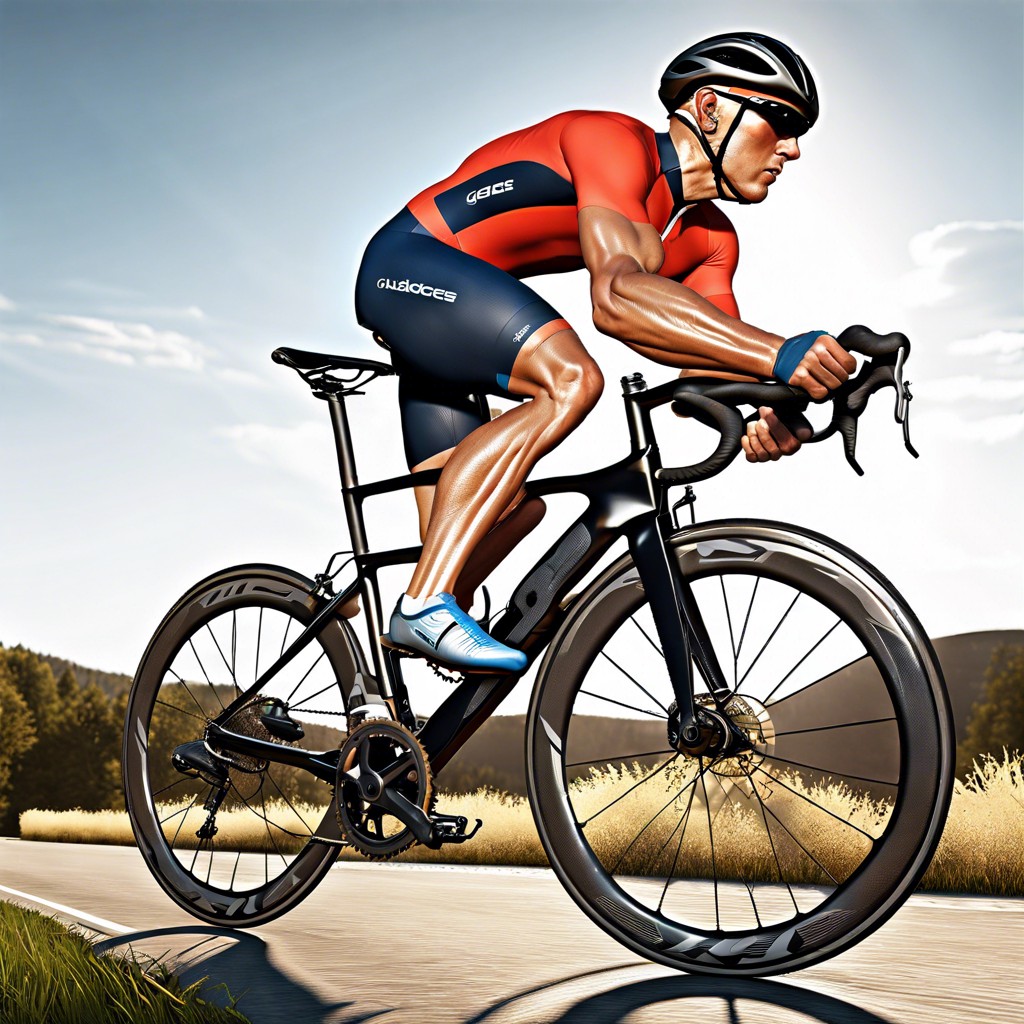Cycling primarily strengthens the legs and core muscles while also offering cardiovascular benefits.
Key takeaways:
- Quadriceps power your pedal strokes for speed and hills.
- Hamstrings provide stability and power, especially climbing hills.
- Gluteus muscles give a powerful push, aiding posture and reducing pain.
- Calves silently power each pedal rotation, improve stability.
- Core stabilizes your body, boosts balance, and power transfer.
Quadriceps

Located at the front of your thigh, these muscles do a lot of the heavy lifting when you pedal. Picture them as the powerhouse engine, driving the pedals down with every stroke.
When you push down, the quadriceps engage fully. Strong quads help you gain speed and power. Climbing hills? That’s when they truly shine, helping you conquer steep ascents effectively.
Cycling mainly targets the rectus femoris, one of the quad muscles. This part handles both hip flexion and knee extension, crucial for a smooth ride.
Working on your quad strength off the bike can also improve cycling efficiency. Exercises like squats and lunges are effective. Boosting their strength can lead to improved cycling performance and reduced risk of injury.
Hamstrings
Cycling does wonders for your hamstrings. These muscles, located at the back of your thighs, play a crucial role each time you pedal.
They act like the backstage crew in a play, often unnoticed but essential for smooth performance. As you push down the pedal, your hamstrings lengthen and contract, providing power and stability.
Think of them as the gears in a well-oiled machine, working in sync with the quadriceps to propel you forward. Strong hamstrings also help in balancing your bike, assisting in both acceleration and deceleration.
Plus, they’re your friends when climbing hills. Hill workouts demand a lot from these muscles, making them stronger over time. This extra strength translates to better overall performance, both on and off the bike.
Gluteus
They’re often the unsung heroes of cycling. When you pedal, these mighty muscles provide that powerful push, especially when climbing hills or sprinting. You might feel the burn, which is a sign they’re working hard.
They’re activated primarily at the top of the pedal stroke, around the 12 o’clock to 3 o’clock positions. This is where you get the most power. Focus on pressing down through your heels rather than your toes.
Fun fact: Strong glutes not only improve your cycling, but they can also enhance posture and reduce back pain. So, next time you’re on your bike, remember to give your glutes the credit they deserve. They play a pivotal role in your ride.
Calf
The lower leg, specifically the calf, plays a pivotal role in cycling. These muscles contribute to the pedal stroke by pushing the pedals forward. Think of them as the silent engines powering each rotation.
When you pedal, the gastroc and soleus muscles engage every push. This movement provides the essential force to maintain your cycling speed. The stronger the calf muscles, the more efficiently you can ride.
Cyclists often experience a burning sensation in the calves after a long ride. That’s a sign of muscles working hard and getting stronger.
Calf workouts off the bike, like heel raises or jump rope exercises, can enhance muscle endurance and help prevent fatigue during your ride. This added strength not only improves performance but offers better stability and balance on the bike.
Never underestimate the contribution of well-conditioned calves. They ensure smoother and more powerful pedaling in every ride.
Core
Pedaling doesn’t just work your legs; it’s a full-body workout. Ever notice how you need to keep yourself stable, especially on a bumpy ride? That’s your core doing its job.
When you ride, your abs and lower back muscles keep you balanced. They stabilize your torso as you pedal. This is crucial, whether you’re climbing hills or cruising on flat terrain.
Think of your core as the silent hero. Strong core muscles help you maintain posture, reducing strain on your lower back. They also play a big role in power transfer. The stronger your core, the more efficiently your leg power translates to pedal strokes.
So, while it’s easy to overlook the midsection, don’t. Engage your core properly, and you’ll find better balance, improved endurance, and fewer aches after long rides. Plus, it’s a neat way to tone those abs without hitting the gym.